여니수니와 함께 떠나는 여수 여행ㆍ5
(Trip to Yeosu with Yeoni and Suni⋅5)
"틀리다고요?""아니에요. 다른 거예요."("Is it wrong?" "No, It's different.")
큰사진보기
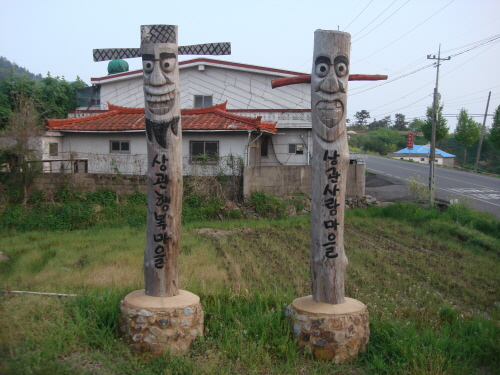
|
| ▲ 장승 상관마을 입구에 세워진 장승이에요. 장승은 지역 간의 경계를 표시하거나 이정표 노릇도 하면서, 마을의 수호신으로 민간 신앙의 대상이기도 하였대요. (There stands a totem pole called Jangseung at the entrance road to Sanggwan village. Jangseung used to indicate a boundary among regions, play a role of milepost and be the object of worship as a village's guardian.) |
| ⓒ 김민지 |
관련사진보기 |
어, '이상하게' 생긴 이게 뭐냐고요? '장승'인데요, 여수에서는 '벅수'라고도 하지요. 우리나라에는 마을 입구에 이런 사람 모양의 목상을 세워 두는데, 이정표 역할을 했지요. 하지만 질병이 돌 때 장승에 제사지내는 일이 있는 것으로 보아 단순한 이정표의 구실을 넘어 질병이나 잡귀로부터 마을을 지켜 주는 수호신으로 역할을 하기도 했어요.
(Do you ask me what this "strange" thing is? This is "Jangseung". And in Yeosu, it is also called "Beoksu". In korea, in front of village's entry, a wooden image which looks like man stands playing a role of milepost. But while a disease was raging, we would perform a memorial service for Jangseung to heal disease. So it's not only just a role of milepost but also a guardian to protect villages from a disease or minor demons.)그런데 웬 장승 이야기를 그리 길게 하느냐고요? ……. 아까 장승을 보고 '이상하게' 생겼다고 했잖아요. 그래요. 처음 보면 이상하다고 할 법도 해요. 친구들이 사는 나라에서는 보기 힘든 목상일 테니까요. 하지만 이상한 게 아니에요. 틀린 게 아니란 말이죠. 그건 틀린 게 아니라 다른 건데, 그걸 이상하다고 하면 조금 섭섭해요. 삶이 다르니 살아가면서 꽃피운 문화 또한 다르지 않을까요? 오늘은 이 문제에 대해 이야기 나누며, 여행을 떠나 볼까 하는데요.
(By the way, Are you saying "why are you talking about Jangseung story so long?" You said it was odd when you looked at Jangseung before. Yes. When you look at this first, you could say like that. In your country it's hard to watch. But it's not strange, moreover, not wrong, it's different, though. I'm a little sad when you say it's wrong. Life is different. So that's why they made culture is also different. Today, we talk about this matter. Let's take a trip.) "우리는 이렇게 입고 살았어요."("We've dressed like this.")
큰사진보기
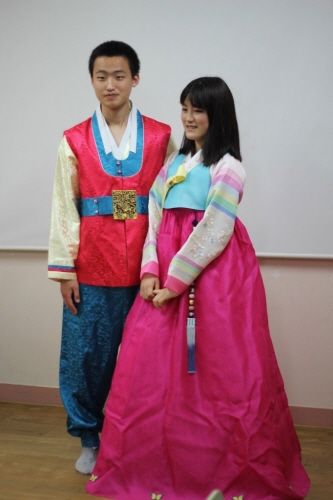
|
| ▲ 한복 우리가 직접 한복을 입어 보았어요. 한복은 우아하고 기품 있는 옷인데, 우리가 입으니 좀 빠져 보인다고요? 에이! (We tried dressing "Hanbok" personally! Do you think Hanbok is graceful, elegant dress but it dosen't look good because we are wearing? Oh, my goodness!) |
| ⓒ 김민지 |
관련사진보기 |
정말 예쁘죠? 이 옷이 바로 우리나라의 전통 의상인 한복이에요. 한복은 오방색이라고 황색・청색・백색・적색・흑색을 적절하게 사용하여 색의 아름다움을 한껏 살린 옷이에요. 그리고 직선과 곡선의 조화는 우리 선조들의 미적 감각을 그대로 드러내기도 하지요.
(It's so beautiful, right? This is korea's traditional clothes "Hanbok". Hanbok has color's beauty by using 5 colors: yellow, blue, white, red, and black. A harmony of straight line and a curved line shows our ancestors' esthetic sense.)옷감도 계절에 따라 달리 사용했어요. 여름에는 삼베나 모시라는 통풍이 잘 되는 시원한 소재를 사용했고, 겨울에는 명주나 무명을 사용해 보온의 역할을 톡톡히 했지요. 한복의 윗도리는 저고리라 부르는데, 저고리는 옷고름을 매서 입었어요. 단추를 잠그는 여느 옷과는 조금 다르지요?
(Fabrics also use differently at each season. In summer, they used cool material such as hemp cloth or ramie fabric that have good ventilation. And in winter, used silk or cotton, so it can keep warm. Hanbok's coat is called 'Jeogori' and it is fasten down by tieing a breast-string.)
큰사진보기
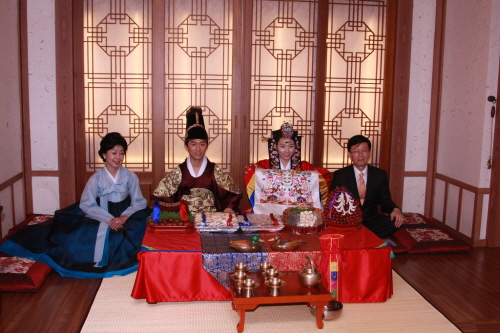
|
| ▲ 폐백 우리나라 결혼식에는 신랑 신부가 집안 어른들에게 인사하는 폐백이라는 의식이 있는데, 그 때 한복을 입은 신랑 신부를 볼 수 있어요. (We have "pyebaek" rite, where bride and groom greet old members of family and at that time we can see them in Hanbok.) |
| ⓒ 손지성 |
관련사진보기 |
한복을 평상복으로 입었던 옛날과는 달리 요즘에는 명절이나 행사 때 격식을 차리기 위해 입는 옷이 되었어요. 엑스포 구경하러 왔다가, 예식장에 한 번 들러 보세요. 한복을 곱게 차려 입은 모습을 볼 수 있을 거예요.
(In old days, Hanbok was ordinary dress. But nowadays it become a special clothes which usually wear in a festive day or event. When you come Yeosu to see Expo, stop by a wedding ceremony hall once. Then, you can see the bride and bridegroom who dress up Hanbok lovely.)"우리는 이렇게 먹고 살았어요."("We've eaten like this.")
큰사진보기

|
| ▲ 양식 포크와 나이프를 사용하여 식사를 하고 있는 모습이에요. 서양 음식을 파는 식당에 가면 쉽게 볼 수 있죠. (It's a picture of eating with a knife and fork. If you go to restaurant selling western food, you can easily see them.) |
| ⓒ 함초롬 |
관련사진보기 |
낯익은 모습이죠? 보통 서양에서는 이렇게 포크와 나이프를 사용해서 음식을 먹는다고 들었어요. 서양 요리는 빵이나 육류가 주를 이루기 때문에 포크와 나이프를 사용하는 게 편하다면서요.
(Are you familiar with this picture? That's right! In the West, people use a knife and fork to eat with. This is because Western food consists of mainly bread and meat. This food is easy to eat with knife and fork.)
큰사진보기
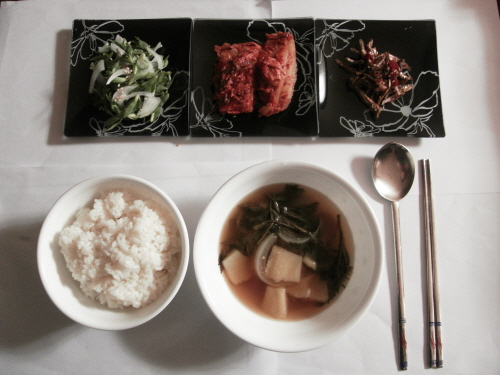
|
| ▲ 한식 우리 밥상이에요. 밥 한 그릇에 국 한 그릇, 그리고 김치. 그리고 밥상에 놓여 있는 젓가락을 한번 눈여겨보세요. (This is a Korean small dining table. There are a rice bowl, a soup bowl, Kimchi dish and chopsticks. Take a good look at the chopsticks.) |
| ⓒ 함초롬 |
관련사진보기 |
숟가락은 서양의 스푼과 비슷해서 별로일 텐데, 젓가락은 신기하죠. 그래서 젓가락을 가리켜 동양의 음식 문화를 상징한다고도 해요. 그런데 젓가락이라고 다 같은 게 아니에요. 중국 젓가락은 길고 일본 젓가락은 짧은데, 우리나라 젓가락은 그 중간쯤 되거든요.
(Because Korea's spoon is similar to Western's, it isn't particularly special. But chopsticks are miraculous. So chopsticks are said to symbolize oriental food culture. But using chopsticks differs from country to country. Chinese chopsticks are long, but Japanese's short and Korean's medium size.)중국은 여러 사람이 둘러앉아 식탁 가운데 놓인 음식을 같이 먹기 때문에 먼 곳의 음식을 먹기 위해서는 젓가락의 길이가 길어야 한대요. 이에 비해 일본은 생선을 발라 먹기 위해 젓가락을 사용하기 때문에 끝이 뾰족하면서도 그 길이가 당연히 짧고요. 그런데 우리는 나물을 주로 먹기 때문에 그 중간쯤 되는 길이의 젓가락이 되었대요. 숟가락으로 밥과 국을 먹고 젓가락으로 나물과 김치를 한번 집어 먹어 보세요.
(Chinese chopsticks are longer than the rests because Chinese people eating at a large table have to reach a long way to get certain food. By contrast, Japanese chopsticks should be short and pointed at the end to separate flesh from the fishbone. Korean chopsticks are in the middle size between those of Chinese and Japanese because Korean food consists of mainly vegetables and Kimchi. When in Korea, try using spoon for rice and soup and chopsticks for vegetables and Kimchi.)"우리는 이런 곳에서 살았어요." ("We've lived in these places".)
큰사진보기

|
| ▲ 기와집 여수의 소호동에 있는 기와집이에요. 고전적인 기품이 있으면서도 직선과 곡선이 어우러진 모습에 감탄이 절로 나오지요. (This is a tile-roofed house with an admirable classical elegance of lines and curves in Soho-dong Yeosu.) |
| ⓒ 김민지 |
관련사진보기 |
그렇다면 우리 선조들은 어떤 집에서 살았을까요? 먹고살 만한 사람들은 기와집에서 살았어요. 기와집은 기와로 지붕을 이은 집인데, 보통 참흙으로 만든 검은색 기와를 많이 썼어요. 기와는 상당히 비쌌기 때문에, 일반 농민들이 짓고 살기에는 어려웠어요.
(Well then, what kind of house did our ancestors live in? Rich people lived in a tile-roofed house. This house has tiled roofs made of soil. And tile-roofed house used a lot of black tiles. As tiles were so expensive, common peoples couldn't afford to build tile-roofed house.)
큰사진보기

|
| ▲ 초가집 옹기종기 함께 모여 있는 초가집이 정겹죠. 50년 전만 해도 대부분의 마을 모습이 이러했어요. 지금은 민속촌으로만 남아 있지만요. (Many thatched houses gathered in a cluster are indeed sentimental. 50 years ago, most villages used to be these features, which is different now. But, thatched houses now remain only in the Folk Village.) |
| ⓒ 김민지 |
관련사진보기 |
이게 바로 우리의 할아버지 할머니들이 살던 초가예요. 우리나라는 벼농사를 하면서 살았어요. 그래서 볏짚을 가지고 지붕을 이었는데, 단열이 잘 되기 때문에 여름에는 시원하고 겨울에는 따뜻하지요.
(This is the very thatched house where our grand father and mother lived. Our ancestors have lived cultivating rice from ancient time. So, they made thatched roof with rice straw, and thanks to adiabatic effect, summer is cool and winter is warm. 50 years ago, thatched house was in general, these days, it is difficult to find out, though.) 그렇다고 완전히 서양식으로 바뀐 게 아니에요. 현대식 아파트에도 우리 선조들의 발명품인 온돌이 그대로 살아 있거든요. 춥고 눈이 많이 내리는 긴 겨울을 지내기 위해 방바닥을 따뜻하게 해 주는 난방시설이 바로 온돌이거든요.
(Yet, the house is not completely changed to Western style . We can still see "Ondol", as a heating system in modern apartment our ancestors invented. A heater that keeps the floor of a room warm for long cold and snowy winter is the very Ondol.)"우리는 아프면 이렇게 고치며 살았어요."
("We've treated disease in these ways.") 그래요. 입는 것, 먹는 것, 자는 곳은 알겠는데, 옛날 우리 선조들은 아프면 어떻게 했을까요? 혹시 드라마 <허준>을 본 적이 있어요? 한번 찾아 보세요. 우리의 전통 의술의 인간 존중의 면모가 아주 잘 녹아 있거든요. 그런데 요즘도 그렇게 병을 고치고 사느냐고요? 당연하죠.
(Yes. You know the way of wearing, eating and sleeping. but, how did they do when they were sick? Did you ever watch the drama <Heo Jun>? Drama <Heo Jun> was televised containing Joseon dynasty's skilled doctor, Heo Jun. Find it out. You can find respect for human in our traditional medical treatment. By the way, Do they get disease treated these days? Sure!) 우리는 아플 때 서양 의학을 바탕으로 병을 치료하는 병원에도 가지만, 전통의 한방 병원에서 치료를 받기도 해요. 우리나라 산하에서 나는 온갖 약초를 다려서 지은 탕제로 병을 다스리기도 하고, 침으로 병을 치료하기도 했어요. 약이야 그렇다 치지만, 아마 침은 좀 낯설 거예요.
(When sick we go to the hospital or oriental medicine clinic. They use herbal tea extracted from several sorts of native herbs in korea. It is strange to foreigners that herbal doctors treat patients with acupuncture.)
큰사진보기
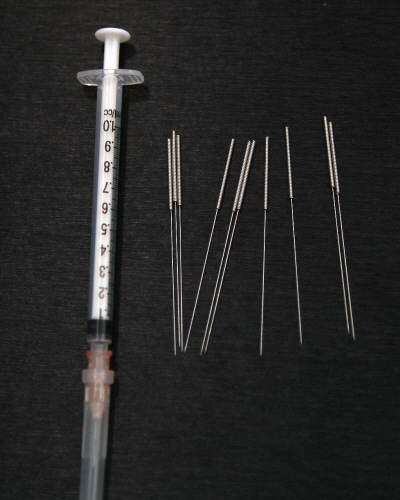
|
| ▲ 주사기와 침 왼쪽에 보이는 게 바로 주사기고 오른쪽에 보이는 게 침이에요. 뾰족하기는 주사기와 같은데 그 쓰임새와 효능은 사뭇 다르죠. (The left is syringe and the right is acupuncture. It looks like sharp syringe, but how to use it and the efficacy of a remedy are different from each other.) |
| ⓒ 양다솔 |
관련사진보기 |
침이란 가늘고 예민한 바늘이에요. 인체의 일정한 부위에 자극을 주어 인체의 기혈을 조절하고 질병을 치료하는 도구죠. 기혈이 뭐냐고요? 그러니까 생체 에너지라고나 할까요.
(Acupuncture is a thin and sensitive needle and gives proper stimuli to some part of body to circulate energy and blood in body, only to treat the disease. Strength and blood is a source of living body's energy.)이처럼 침은 약물을 넣어 생물체의 조직이나 혈관 속에 직접 주입하는 도구인 주사기와는 다르죠. 몸이 아프면 아픈 부위만을 다스리는 서양 의학과는 달리 우리 한의학은 몸 전체를 다스려 스스로 아픔을 이겨내는 그런 원리래요. 침과 주사기, 동서양 문화를 상징하는 느낌이 들죠?
(Like this, acupuncture is different from syringe which is directly injected in tissue and blood vessel. Western medical treats a painful part of the body but oriental medicine treats the whole body. So oriental medicine has a principal that overcomes disease for oneself. Acupuncture and syringe symbolize a difference of eastern and western culture.)어떻게 그리 잘 아느냐고요? 당연히 한의사 선생님을 찾아가 배웠죠. 그렇다고 동서양 의학이 완전히 담을 쌓은 것은 아니에요. 요즘은 병원에서도 아픈 곳의 자극을 풀어주기 위해 긴 침을 사용하기도 하고, 한의원에서도 주사기에 약을 넣어서 침 치료를 한대요. 서로 보완하려는 모습이죠.
(How do we know about it? Surely we were taught by oriental doctor. Both eastern medical and oriental medicine do not always show strong disapproval of each other. Nowadays, even though hospitals are using long needles in order to abirritate, herbal clinics are using syringes to put some medicines in. They complement their shortcomings each other.)저도 체육대회 때 닭싸움을 하다가 발목을 삐어서 한의원에서 침을 맞고 금방 나았어요. 아프지 않고 조금 따끔거릴 뿐이니, 너무 겁먹지 마세요. 여수에 와서 엑스포도 구경하고, 그래서는 안 되겠지만, 가볍게 삐게 되면 침을 맞아 보세요. 신기하고 좋은 경험이 될 거예요.
(Once I had my ankle sprained in the school sports, and had a treatment with acupuncture at oriental medical clinic. Not sick but prick. Don't be scared. When you visit Yeosu to have sights of the Expo, if you should sprain your ankle by chance, try being treated with acupuncture at oriental medical clinic. It'll be surprise and good experience to you.)"템플스테이에 가면 이 모든 것을 느낄 수 있어요."
("Go to temple staying, and you will see all of these.") 이처럼 우리는 우리의 삶이 만들어 낸 우리의 문화에 젖어 살아왔어요. 우리는 그렇게 입고, 그렇게 먹으며, 그렇게 자고, 그렇게 고치면서 살았어요. 그런데 우리의 이런 모든 문화를 한꺼번에 체험할 수 있는 게 있어요. 그게 뭐냐고요? 템플스테이. 여수에서 가장 가까운 흥국사로 가 볼까요.
(In this way we have lived, going through our culture of our lives achieved. It is the way we have lived, wearing, eating, sleeping, and healing disease so. By the way, There is a place to experience all of these cultures together. Do you know what? It is the "Temple stay". Shall we go to the closest temple from Yeosu, "Heungguk" temple.)
큰사진보기

|
| ▲ 흥국사 흥국사에서 템플스테이를 체험할 수 있는 절집이에요. 우두커니 앉아 있는 스님의 정적이 한없이 고요하게 보이죠. (It's a house in the temple where we can experience temple stay. Look at that buddhist sitting silently. Isn't it peaceful?) |
| ⓒ 함초롬 |
관련사진보기 |
우선 기와집이 눈에 띄죠. 예전에 기와집은 한국의 양반들만 살 수 있었으니 '양반 대접' 한번 받아 보세요. 몸도 마음도 넉넉해질 거예요. 그러고 앞에 여자분이 입고 있는 옷을 보세요. 개량 한복인데 템플스테이를 하면 입어 볼 수 있어요. 편해 보이는 이 옷은 절에서의 우리 문화의 여유를 느끼게 해 줄 거예요.
(Let's see. Could you notice "the tile-roofed" house, Korean traditional house? Long ago, it was only for noble-men called 'Yangban', korean ruling classes at Joseon dynasty. So feel what the yangban is. Your mind and body will get generous. And can you see the costume worn by woman? That is improved "Hanbok", and maybe one can wear it during temple stay. This seemingly comfortable clothes have you feel peaceful sense of our culture.)
큰사진보기
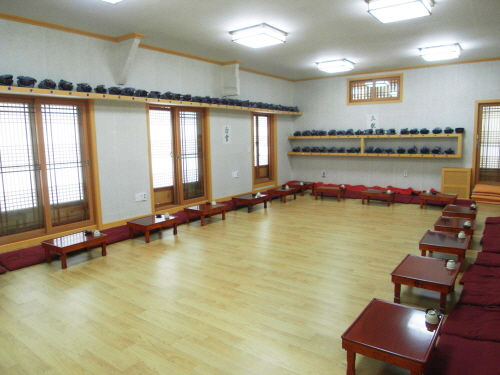
|
| ▲ 흥국사 발우공양 템플스테이를 하는 방 안 모습이에요. 정갈함과 넉넉함, 그리고 품격이 함께 느껴지는 곳이에요. (Here is a picture taken in the room for temple stay, feeling neatness, adequate and dignified.) |
| ⓒ 함초롬 |
관련사진보기 |
방안에 들어가 볼까요? 스님들이 공부도 하고 밥도 드시는 상이 보이죠. 불교에서는 밥 먹는 것을 '공양'이라고 하고, 이 때 쓰는 그릇을 '발우'라고 하죠. 템플스테이를 하게 되면 발우공양이 아주 인상적일 거예요. 자기가 먹은 음식 그릇을 물로 씻은 다음 그 물도 먹어 전혀 음식 쓰레기를 남기지 않은 식사법이거든요. 환경 문제에 대한 성찰을 할 수 있는 시간일 거예요.
(Let me show you the room. In the room, there are large tables monks use for studying and meals. Having a meal in temple is called "Gongyang" and bowls for it are called "Balu". Gongyang and Balu will be likely to be very impressive to you, for after washing dishes using a little water, drinking that water without any waste is helpful for environment.)
그러나 템플스테이를 하면서 제일 좋은 것은, 마음을 놓아 버리는 거예요. 온갖 스트레스를 잠시나마 놓을 수 있다는 것 자체가 지친 마음을 치료하는 방법일 테니까요. 템플스테이가 애초에 휴식과 명상을 통한 치료를 목적으로 출발했다고 하니까, 종교가 달라도 관계없으니 많이 참여해 주세요."
(But the best thing you can get from doing temple stay is that you can enter into the priesthood. Getting rid of stresses itself is the way of curing mind. Temple stay originally started with a view to treatment through relaxation and meditation. So "regardless of religion, how about taking part in temple stay?")
"틀리다고요? 아니에요. 다른 거예요."
("Is it wrong? No. It's different.")
큰사진보기
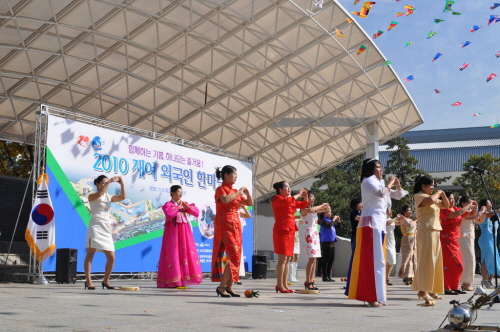
|
| ▲ 외국인 한마음축제 외국인 축제 한마당에서 전통 의상을 입고 춤을 추는 외국인 친구들이에요. 다양한 문화가 만나 조화로운 춤으로 거듭나게 하는 곳이 여수예요. (Here are some foreign friends who wear traditional costumes dancing in the festival. Yeosu is the place where various cultures mingled with one another would be made again only to be harmonious dance.) |
| ⓒ 손지성 |
관련사진보기 |
우리나라는 외국인들이 벌써 120만 명이 넘어서고 있어요. 처음에는 문화의 '다름'을 '틀림'으로 생각하고 이런저런 마찰도 빚었지만, 이젠 함께 만들어 가는 공존과 화합으로 나아가고 있어요.
(Foreign residents already surpassed 1.2 million in Korea. At first, we mistook the culture difference for being wrong and there were a lot of trouble between us. but now, we are making progress with coexistence and harmony.)
이번에 엑스포에도 100여 개의 나라가 참가하여 각기 다른 문화를 소개할 텐데, 아마 세계의 다양한 문화가 만들어 낸 축제의 꽃밭을 만들어 낼 거예요. 물건만 보여주는 박람회가 아닌 아름다운 우리의 문화를 보여주는 박람회. 바로 이것이 저희가 꿈꾸는 엑스포예요.
(Over 100 countries may participate in this Expo and they are going to introduce their own culture. Probably, it will be a flower garden which is made by the diverse culture from all over the world. It is not the exhibition which displays simple things, but shows our beautiful culture. That is exactly the Expo we dream.)
큰사진보기

|
| ▲ 엑스포 성공을 기원하며 옛날에 우리 조상님들이 그러셨듯 간절한 마음으로 여수세계박람회의 성공을 빌어보았어요, 장승 곁에서. (We sincerely pray for success of International Exposition Yeosu Korea 2012 as our ancestors did standing near by Jangseung.) |
| ⓒ 장영옥 |
관련사진보기 |
지나가다가 길거리에서 벅수를 만나거든, 아 이게 한국인의 삶이 묻어 있는 바로 그 장승이구나 하면서 사진 한 컷 찍으세요. 우리처럼 활짝 웃으면서. 여러분 마음속의 무엇인가를 기원하면서.
(When you meet the Beoksu on the street, take a picture and think of it inhabiting in Korean life. Smiling like us, pray for something you want.)
(기사 작성 : 동아리 <사랑해여수> 김민지, 손지성, 함초롬, 양다솔, 임혜연, 위수환 기자. 지도 교사 : 박용성)
(News written by the group of 'ILOVEYEOSU' : Kim Minji, Son Jiseong, Ham Chorom, Yang Dasol, Lim Hyeyeon, Wee Suhwan. Guidance teacher : Park Yongseong)
덧붙이는 글 | <사랑해여수>는 2012년 여수엑스포를 젊은이의 시각으로 세계에 알리기 위해서 조직된 동아리입니다. 우리 동아리는 올해부터 부영여고 자체 동아리에서 여수지역 고등학교 연합동아리로 확대되어 운영하고 있습니다. 이 기사는 <사랑해여수> Y팀에서 작성한 것입니다.